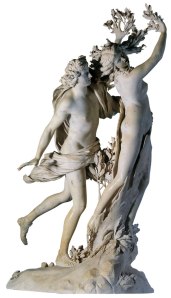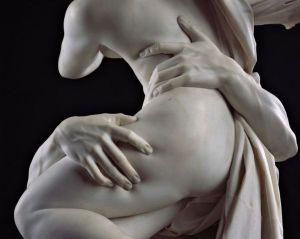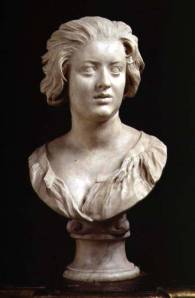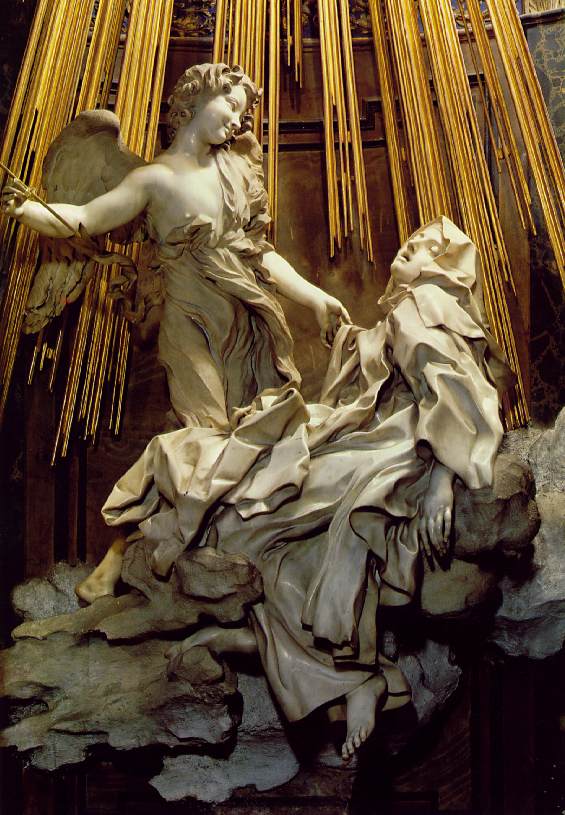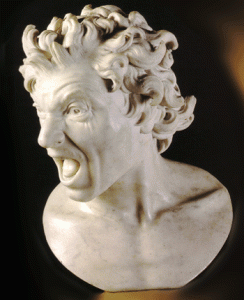
A self portrait Bernini did in which he burned himself repeatedly with fire in front of a mirror so that he could get the expression right.
Bernini was a 17th century Baroque artist. He was a painter, architect, and playwrite, but what he is most famous for is his sculptures. In fact most of Rome’s grandeur can be attributed to Bernini. It is said that when he was 8 years old he carved a bust that marveled everyone who saw it. Only a few years later, many people were saying that they hoped him to be the next Michelangelo. He first trained under his father Pietro, an Italian sculptor at the time, assisting him with his pieces, but quickly found commissions of his own. He went on to do work for 8 different popes, and spent his entire career in Rome. In fact, he only left Rome once as an adult, to travel to France. He was invited by King Louis XIV to design an addition to the Louvre, which he rejected. He didn’t like France much. The entire time he was there, he complained that, “All of Paris was worth less than a painting by the Itallian artist Guido Reni.” Now I can’t say I found out a whole lot about Guido Reni, except that he was a realist painter who did idealistic paintings that were highly sought after by the wealthy class, but I am assuming that this is highly insulting. He did compliment Francois Mansart (the French architect who remodeled the louvre), but said that he would have been even better had he been from Rome.
Bernini started making a name for himself and establishing his style from the get-go. One of his first independent commissions was requested by Cardinal Scipione Borghese to do a series of larger-than-life Marble statues. One of these was his famous statue Apollo and Daphne (1622-24), which illustrates the myth about Daphne, the nymph who caught the unwanted attention of Apollo. The statue depicts the moment when Apollo finally has her within his clutches, which is also the moment that Daphne’s father turned her into a laurel tree, so as to escape his lustful intentions. Bernini did a beautiful job showing the subtle changes, transforming the cold marble into warm flesh, showing her skin changing to bark, her turning into root tendrils and her fingers becoming leaves. Apollo is depicted with an expression caught between lust and a realization about what is happening. Everything is carved with painstaking detail, to depict exquisite perfection. Though this is his one of his famous works, the interesting thing is that the works most acclaimed features cannot be attributed to Bernini. He focused mostly on the two main figures, while his assistant, Guiliano Finelli, did much of the work on the roots, branches, and hair. Finelli was bitter about the lack of credit that he was given, so he went on to have a successful, independent career of his own, mostly doing busts, but keeping the same level of exquisite detail.
Bernini was passionate in the work that he did. “According to a friend’s description, the sculptor could carry on a lively conversation about the topics of the day, all while ‘crouching, stretching…marking the marble with charcoal in a hundred places, and striking with the hammer in a hundred others; that is, striking in one place and looking in the opposite place.’” The interesting thing is that when he was working, he almost never made a terra-cotta model first, and sometimes he didn’t even use a human model at all. He was also obsessed with the idea of overcoming the restrictions of a material. When he worked with white marble, he would try to suggest color. He would transform the cold, hard material, into soft fleshy tones, making it appear as though the surface was rippling and lively, filled with warmth and movement. As though it could jump to life at any time.
Bernini really had it all. He had talent, charm, and connections. But he did not get all this without making some enemies. In Bernini’s time, there was a call for artists to remodel St. Peters. Francesco Boromini, the Roman architect who designed many of the baroque buildings in Rome, was much more qualified, for he had trained as an architect and already made a name for himself in Rome. However, Bernini got the job. Why? Well, partly because he was an amazing sculptor, partly because he was charming and could talk circles around the socially inept Boromini, and partly because he was the Popes best friend.
The image to the right is one of the few busts that Bernini carved. He preferred to work on larger, more dramatic, sculptures. If he was going to do a bust, it was generally of someone that he couldn’t say no to, such as the Pope, or a king. However, this particular bust is really something else. It was done of his lover, Constanza, wife of one of his assistants. A beautiful sculpture, lovingly carved, etching her beauty in history. You can see the fire and passion on her face, succulent lips parted slightly as though she is about to speak, and the fabric of her blouse falling away from her breast. It could possibly be the most erotic busts in European history. However, this bust is also surrounded by scandal. Bernini, while being charming, and talented, was also known for having a quick temper. When he found out that his younger brother, Luigi, was also sleeping with Constanza, he attacked his brother, almost murdering him, and sent a servant to slash Constanza’s face to ribbons with a razor blade. What was the penalty for this? A slap on the wrist and an order for the Papacy to marry the woman of his choosing, who just happened to be the most beautiful woman in Rome. His new wife would not have the bust of Constanza in the house, and before he could smash it, a Medici buyer from Florence snapped it up.
Bernini later went on to do The Ecstasy of St. Teresa, in which he brings to life a quote from Teresa’s biography. “Very close to me, an angel appeared in human form. I saw in his hand a long spear of gold, and at the iron’s point there seemed to be a little fire. He appeared to me to be thrusting it at times into my heart, and to pierce my very entrails; when he drew it out, he seemed to draw them out also, and to leave me all on fire with a great love of God. The pain was so great, that it made me moan; and yet so surpassing was the sweetness of this excessive pain, that I could not wish to be rid of it. The soul is satisfied now with nothing less than God. The pain is not bodily, but spiritual; though the body has its share in it. It is a caressing of love so sweet which now takes place between the soul and God, that I pray God of His goodness to make him experience it who may think that I am lying.” He wanted to show the image of a woman longing for her soul to be satisfied by God, for she wrote in such a way that it made it sound as though her soul and body were the same thing. So he showed her locked in the only expression that he knew of that could even come close to duplicating the tide of engulfing feeling that was going on in side her, with the face of a woman in the hight of orgasm in liquid bliss. This statue was made for a church in Rome, the first one to be built in memory of St. Teresa, who was a modern Saint at the time.
Below is a really great documentary about the life of Bernini that is actually a really good biography of Bernini. They cover everything from examining the pieces to little gossip tid bits about him. If you have the time, and are interested, i know it is long, but it is really good.
Below is another video in which they talk about my favorite piece, Pluto and Proserpina (also known as The Rape of Proserpina). It is a short clip, but they go into a lot of detail about the exquisite nature of the piece.
References:
